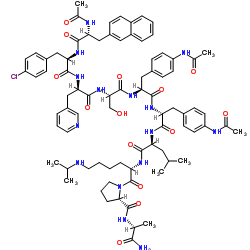170157-13-8
| Name | S3439D3B35 |
|---|---|
| Synonyms |
D-Alaninamide, N-acetyl-3-(2-naphthalenyl)-D-alanyl-4-chloro-D-phenylalanyl-3-(3-pyridinyl)-D-alanyl-L-seryl-4-(acetylamino)-L-phenylalanyl-4-(acetylamino)-D-phenylalanyl-L-leucyl-N6-(1-methylethyl) -L-lysyl-L-prolyl-
N-Acetyl-3-(2-naphthyl)-D-alanyl-4-chloro-D-phenylalanyl-3-(3-pyridinyl)-D-alanyl-L-seryl-4-acetamido-L-phenylalanyl-4-acetamido-D-phenylalanyl-L-leucyl-N6-isopropyl-L-lysyl-L-prolyl-D-alaninamide S3439D3B35 |
| Description | Acyline , a GnRH peptide analogue, is a GnRH antagonist that inhibits gonadotropin and testosterone (T) levels[1]. |
|---|---|
| Related Catalog | |
| In Vivo | Acyline (50 μg, s.c., two daily, 5 days) can result in disruption of vaginal oestrus and reduce uterine weights in female Kiss1−/−and Gpr54−/− mice, as well as a decrease in LH concentrations of female Kiss1−/− mice[1]. Acyline (50 μg, s.c., once) can reduce FSH concentrations from pre-acyline 1.51 ng/mL to post-acyline 1.27 ng/mL in male Kiss1−/− mice and from pre-acyline 2.87 ng/mL to post-acyline 1.95 ng/mL in male Gpr54−/− mice[1]. Animal Model: Female Kiss1−/−and Gpr54−/− mice[1] Dosage: 50 μg (1 mg/mL in PBS) Administration: Subcutaneous injection; two daily; 5 days Result: 12 Kiss1−/− mice left oestrus within 4 days of 13 mice received acyline while only 2 of 17 mice received vehicle left oestrus. Also, 7 of 8 Gpr54−/− mice received acyline left oestrus compared to 1 of 7 received vehicle. Reduced uterine weights of Kiss1−/−and Gpr54−/− mice in treated group compared to the vehicle group, and reduced serum LH concentrations in Kiss1−/− mice. |
| Density | 1.3±0.1 g/cm3 |
|---|---|
| Boiling Point | 1774.1±65.0 °C at 760 mmHg |
| Molecular Formula | C80H102ClN15O14 |
| Molecular Weight | 1533.211 |
| Flash Point | 1026.7±34.3 °C |
| Exact Mass | 1531.741943 |
| LogP | 5.71 |
| Vapour Pressure | 0.0±0.3 mmHg at 25°C |
| Index of Refraction | 1.611 |
